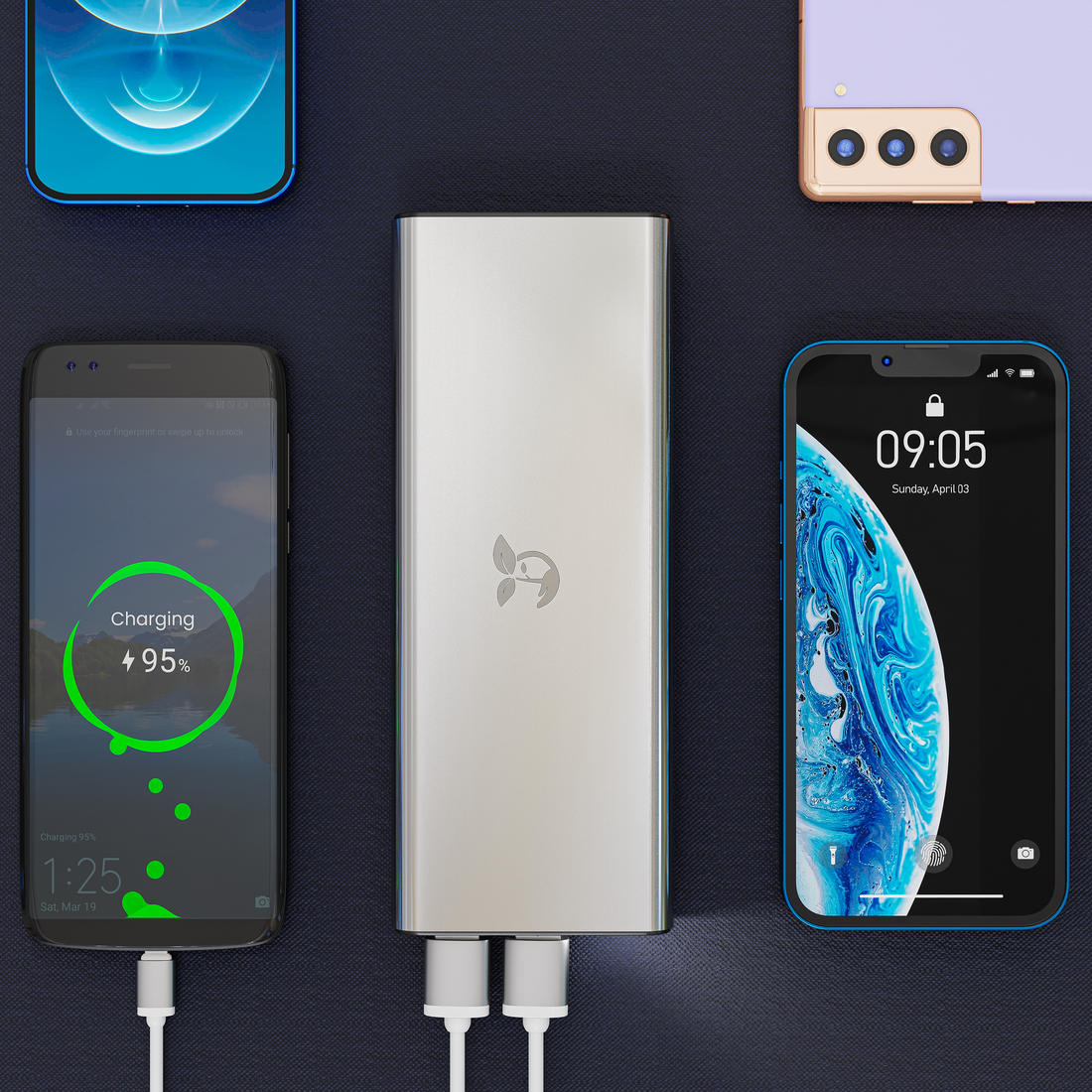Table of Contents
I. Introduction
In today's world, electronic devices such as smartphones, tablets, and laptops have become an integral part of our daily lives. However, with increased usage comes the need for reliable power sources. This is where power banks come in, providing a portable and convenient way to charge our devices on the go.
But have you ever wondered how power banks store and release energy? Understanding the science behind power banks can help you choose the right one for your needs and use it safely and effectively. In this blog post, we'll take a closer look at how power banks work and the factors that can affect their performance. We'll also provide tips for maximizing their lifespan and safety.
II. How Power Banks Store Energy
Power banks store energy in a rechargeable battery, typically made up of several battery cells. The most commonly used battery cells in power banks are lithium-ion (Li-ion) and lithium-polymer (LiPo) cells. These cells have a high energy density, meaning they can store a lot of energy in a relatively small size.
In addition to the battery cells, power banks also have control circuitry that manages the charging and discharging of the battery. The control circuitry regulates the input voltage and current from the charging source (such as a USB port or wall adapter) to ensure the battery is charged safely and efficiently.
When a power bank is connected to a charging source, the control circuitry manages the flow of electricity to the battery cells. The charging process typically consists of two stages: bulk charging and trickle charging. During the bulk charging stage, the battery is charged quickly with a high current until it reaches around 70-80% capacity. The trickle charging stage then follows, where the charging current is reduced to avoid overcharging the battery.
Overall, the battery cells and control circuitry work together to store energy in a power bank and make it available for charging devices on the go.
III. How Power Banks Release Energy
When a power bank is fully charged, it can release stored energy to charge electronic devices such as smartphones, tablets, or laptops. The release of energy is controlled by the same circuitry that manages the charging process.
To release energy, the power bank's output port is connected to the device being charged with a compatible cable. The control circuitry then manages the flow of electricity from the power bank's battery cells to the device being charged. The output voltage and current are regulated to ensure the device is charged safely and efficiently.
The release of energy from a power bank can be affected by several factors, including the capacity of the power bank, the charging rate of the device being charged, and the quality of the charging cable. It's important to use a power bank with a capacity that matches the needs of the device being charged. Using a power bank with a lower capacity may not provide enough energy to fully charge the device, while using a power bank with a higher capacity may result in excess energy that can damage the device being charged.
In addition, using a low-quality charging cable can also affect the release of energy from a power bank. Poor-quality cables may have higher resistance, which can cause energy loss during transmission and result in slower charging times. It's recommended to use high-quality cables that are compatible with both the power bank and the device being charged to ensure optimal performance.
Overall, the release of energy from a power bank is a crucial aspect of its functionality. By understanding how power banks release energy and the factors that can affect their performance, you can choose the right power bank for your needs and use it safely and effectively. Re-write the previous text but way more in detail.
IV. Factors Affecting Power Bank Performance
While power banks are convenient and portable sources of energy, there are several factors that can affect their performance. Here are some key factors to consider:
- Capacity: The capacity of a power bank refers to the amount of energy it can store. A power bank with a higher capacity can provide more energy and charge devices multiple times before needing to be recharged itself. However, using a power bank with a much higher capacity than the device being charged can lead to excess energy that can damage the device.
- Charging rate: The charging rate of the device being charged can affect the performance of the power bank. If the device has a high charging rate, it may drain the power bank faster and result in shorter overall battery life. It's important to choose a power bank with a compatible charging rate to ensure optimal performance.
- Quality of the charging cable: The quality of the charging cable used to connect the power bank to the device being charged can also affect the performance of the power bank. Poor-quality cables may have higher resistance, which can cause energy loss during transmission and result in slower charging times. Using a high-quality, compatible charging cable is recommended for optimal performance.
- Operating temperature: The operating temperature of the power bank can also affect its performance. Extreme temperatures, both hot and cold, can cause the power bank's battery cells to degrade faster and reduce its overall battery life. It's important to avoid exposing the power bank to direct sunlight or extreme temperatures.
- Age and condition: Like all batteries, power bank batteries can degrade over time with repeated use. It's important to check the age and condition of the power bank regularly and replace it if necessary to ensure optimal performance.
By taking these factors into consideration, you can choose the right power bank for your needs and use it effectively to ensure optimal performance and longevity.
V. Tips for Maximizing Power Bank Performance
To ensure that your power bank performs at its best and lasts as long as possible, there are several tips you can follow:
- Choose the right capacity: The capacity of your power bank should match the needs of your device. If you have a smartphone with a small battery, a power bank with a capacity of 5000mAh may be sufficient. However, if you have a tablet or laptop with a larger battery, you may need a power bank with a capacity of 10000mAh or more.
- Use high-quality cables: Using a low-quality charging cable can affect the performance of your power bank. Poor-quality cables may have higher resistance, which can cause energy loss during transmission and result in slower charging times. It's recommended to use high-quality cables that are compatible with both the power bank and the device being charged to ensure optimal performance.
- Keep the power bank cool: Excessive heat can damage the battery cells in your power bank, so it's important to keep it cool while it's charging or discharging. Avoid leaving your power bank in direct sunlight or in a hot car. If the power bank becomes too hot, stop using it and allow it to cool down before charging it again.
- Charge the power bank regularly: If you don't use your power bank for an extended period of time, the battery cells may become damaged or lose their capacity. To prevent this, it's recommended to charge your power bank at least once every three months, even if you don't use it regularly.
- Don't overcharge or overdischarge the power bank: Overcharging or overdischarging your power bank can damage the battery cells and reduce its lifespan. Always follow the manufacturer's instructions for charging and discharging your power bank, and avoid leaving it plugged in for longer than necessary.
By following these tips, you can ensure that your power bank performs at its best and lasts as long as possible, providing you with reliable and convenient portable power whenever you need it.
VI. Conclusion
Power banks have become an essential accessory for many electronic devices users, providing a convenient way to charge their devices on-the-go. Understanding how power banks store and release energy, as well as the factors that affect their performance, can help you choose the right power bank for your needs and use it safely and effectively.
When it comes to storing energy, it's important to choose a power bank with a capacity that matches the needs of your device. Consider the number of battery cells, the output voltage and current, and the charging speed to ensure that you're getting the best performance possible. Also, make sure to store your power bank in a cool, dry place to maximize its lifespan.
To release energy, connect your power bank to your device using a compatible cable and ensure that the charging cable is of high-quality to avoid energy loss during transmission. Also, avoid using your power bank in humid or wet conditions unless it's IP rated.
Finally, to maximize the performance of your power bank, it's recommended to fully charge and discharge it at least once every few months. This helps to recalibrate the battery cells and maintain their efficiency over time.
By following these tips and understanding the key aspects of power bank technology, you can ensure that your power bank is working at its best and keep your electronic devices charged and ready to go whenever you need them.

